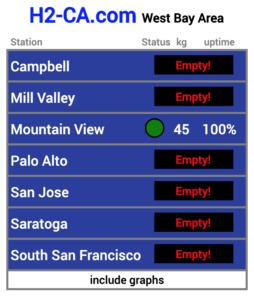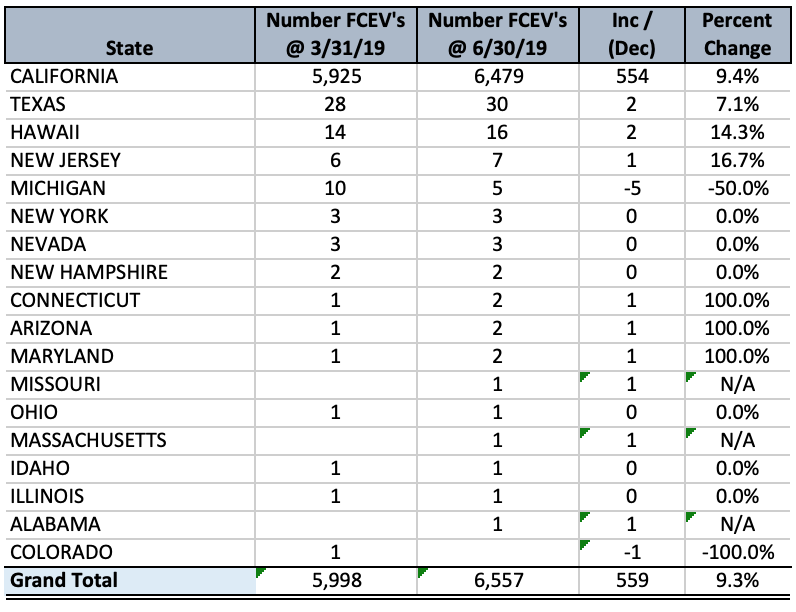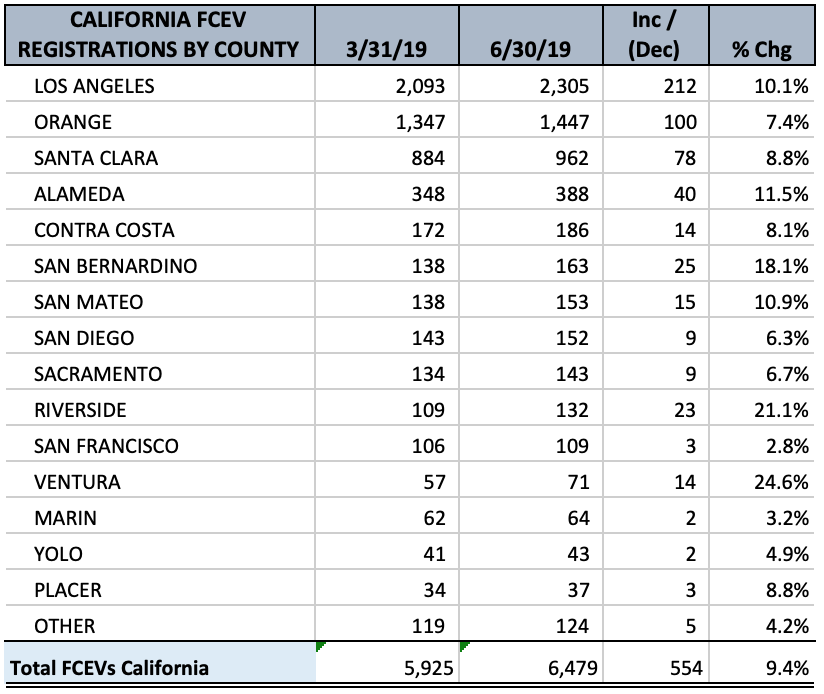Welcome new readers of RMP’s quarterly H2 infrastructure report. Each quarter RMP looks back on the major stories related to hydrogen infrastructure advancements and we compare the current AFDC database to the AFDC database in the prior quarter to see what has changed. The AFDC database is updated by the US Dept of Energy & can be found by clicking here. AFDC stands for Alternative Fuels Data Center and it’s where the US government keeps stats on all alternative fuels’ infrastructure. Canada does not have a centralized database of alternative fuel vehicle information so we collect Canadian data by hand in RMP’s own data tables. Ok, on with the report…

The third quarter of 2019 has for the most part been a disappointment for advocates of zero emission hydrogen fuel cell infrastructure developments. It was only in the last couple weeks that we received some good news to end the quarter on a high note to carry some momentum into 2019-Q4. While in general there seems to be an abundance of positive momentum for hydrogen advancements in the headlines, the simple truth is there is one metric that matters more than any other: the number of refueling stations open & their uptime. This key infrastructure metric has been flatly disappointing throughout 2019-Q3. Hydrogen refueling station openings & planned capital expenditure announcements to create more infrastructure have seemed to stagnate over the last two quarters as well. Let’s get this quarter’s disappointing news out of the way and then circle back to the positive developments that happened in just the last couple weeks.
This is the second quarter in a row that there are no new records showing new planned stations in the AFDC database. The only activity on the station update list is that the US government has removed military stations from the database. No new stations on the list 🙁 . This is a key metric that we all have to be real about, it’s the A#1 bottleneck holding back faster uptake of hydrogen fuel cells. Automotive manufacturers have the capability to begin ramping up mass manufacturing production lines to start building fuel cell vehicles faster, but will not do so until the fueling infrastructure warrants the effort.

Further exacerbating the slow increase in the number of stations on the list over the past two quarters are the number of stations listed as open but the tanks are empty. For all practical purposes to drivers, these stations do not exist. The problem has been worst in the San Francisco Bay area as indicated in Fig1 which shows 6 of the 7 stations in the West Bay area are off-line and the 1 and only station operating has 45kg on hand as of 9/18/18 6:45PM. These refueling locations cannot stay filled and therefore cannot stay open because of delivery issues. If you’re reading this you probably already know hydrogen’s abundance in our universe is not the problem, hydrogen production & delivery logistics are creating this problem. The hydrogen logistics issues through Q3 stem from one event in Santa Clara that halted most shipments.
The explosion at the Air Products hydrogen production facility on June 2, 2019 has impacted delivery to all stations in Northern California. Hydrogen distribution constraints & production locations need to ramp up to provide the redundancy needed to give consumers the confidence they will need for adoption to continue to increase. The Air Liquide project to invest $150 million USD to build a hydrogen liquefaction plant announced in November of 2018 is something RMP mentioned in our 2018-Q4 report. The new Air Liquide facility should be capable of producing 30 tons of hydrogen per day and that’s enough for about 35,000 vehicles.
Hydrogen advocates should not despair RMP’s lamenting of Q3 glum news as there is hope & progress ahead of us. We must remember hydrogen fuel cell adoption is a lot like the bunny hop. We take three jumps forward then we take a jump back. Then another three steps forward and then one back again. Let’s look at the bright side here before we get into the numbers by looking at some of the following “good” bullet points of how we can expect to take another few “bunny hop” leaps forward soon. Below are few bullet points of how things look brighter looking forward.
- 15 of California’s “open” stations are either empty or off-line because of the “Santa Clara” set back. When Air Products’ Santa Clara facility comes back online and normal deliveries resume, drivers in the San Francisco bay area will feel like multiple stations came back online all at once. It will be a big relief to get distribution back to normal for stations that are ready to receive & dispense hydrogen to consumers. And, as facilities like the Air Liquide liquefaction plant come online, the redundancy of having more production locations will help make situations like the “Santa Clara” incident less likely to occur in the future.
- 7 stations are currently commissioning to come online in California soon. With the other 15 that should come back when distribution issues are resolved, the “real feel” of stations coming online in California could be more like 22 new stations coming online all at once. This could make a lot of drivers very happy.
- The 41st Hydrogen Refueling Station (HRS) that just opened in Oakland California on 9/20/2019 is a giant leap forward in HRS capability. This station will have a capacity of 800kg making it more than three times larger than any of the previously opened First Element HRS stations under their True Zero brand. The station will also offer two fueling points so two cars can refuel simultaneously. 800kg of H2 can provide over 26,500 kWh of energy to about 160 cars per day. When the fuel tank is empty, just refill and keep going (see John Hunt’s tweet below). The Oakland station shows that by using liquid hydrogen technology, new stations can scale reliably as the number of drivers increase. The first 40 stations were/are what I would call “demonstration stations”. This new Oakland station is much bigger and more a “normal commercial use” station. Hydrogen refueling stations can also be a much bigger too if necessary, hydrogen can scale to support everyone cost effectively relative to other zero emission technologies like battery electric vehicles.
New station stores 800kg #hydrogen >26,500 kWh of energy ~160 full #fuelcell cars a day from 2 pumps able to cover ~50,000 miles & when it’s empty refill it and go again . Well done @truezeronetwork @CaFCP 💪🌿💦 https://t.co/hNiQM8fQAi
— Jon Hunt (@JontheHunt) September 21, 2019
- Momentum with companies announcing hydrogen product developments and investments into hydrogen companies is at a fever pitch. If you follow HyTwit (hydrogen twitter) there are more hydrogen advocate twitter accounts & news articles being shared than ever before. I saw a recent tweet storm for a 100 bus order in Zhejiang Province in China for example which is the biggest single bus order I have ever seen in following hydrogen headlines for over 5 years now. New bus orders, advanced VTOL aircraft, storage applications, & stationary applications for hydrogen fuel cells are popping almost every day. RMP has included some of the highlight stories from this past quarter below in the Important Headline Links section.
Let’s look at the data updates from 2019 Q3:
Ok, let’s get into the numbers (or lack thereof) from the AFDC database and then after that, RMP will go over numbers of FCEVs on the road using IHS Markit data in the final remarks section to close out this article.
New H2 Stations That Opened To The Public 2019 Q3:
By the nick of Q3’s chinny chin chin, 1 HRS station opened on 9/20/19 just before the quarter ended on 9/30/2019. While it was only one and at the last minute, the Oakland station just described in the bullet point above is not just any station. The new Oakland California station has an 800kg capacity. Liquid hydrogen stations like the new Oakland California station demonstrate how hydrogen scales to meet the needs of energy hungry consumers with the ability to refuel 160 cars per day from two pumps.
H2 Stations Removed from the AFDC Database 2019 Q3:
All of the US Military stations were removed from the AFDC database over the last quarter. RMP has doubts that these stations were closed per se but probably removed from the data set for other reasons. Luckily RMP has the locations of the military stations from previous downloads so RMP will keep them on RMP’s map of all hydrogen stations in the USA until it can be determined what their true status is. We know General Motors & Honda will begin mass manufacturing of gen2 fuel cell stacks in Brownstown Michigan next year. General Motors #1 customer for advanced hydrogen fuel cell propulsion systems is the US Military. The US Military is focused on using JP8 to make hydrogen for their vehicles & reclaiming the water produced from the fuel cell for soldiers to drink.
H2 Stations Added to the AFDC Database 2019 Q3:
Unfortunately, there were zero new records for HRS added to the AFDC database in 2019-Q3. As stated in the opening remarks of this article, this is the most important statistic in hydrogen FCEV adoption. There is no more meaningful metric at this point than the number of stations on the list and open. The main point of this quarterly publication is to watch this important metric. It really is this simple: build the stations & the cars will sell. For point of reference, the Oakland station that just opened has been on the AFDC database for well over a year. It was on 12/31/2018 that RMP announced the Oakland station moved from a status of Planned to Under Construction. It’s important to see new records on the database for hydrogen stations as it takes time to get permitted, planned, built, commissioned, and then finally opened. We hope to see some new records on the database soon to keep the momentum going. One station RMP is very hopeful to see is the forthcoming Fuel Cell Energy & Toyota collaboration station at the Port of Los Angeles. The Port of Los Angeles station for Class 8 vehicles will be the most game changing refueling station in the world. Looking forward to reporting that station in this section soon.
Important Headlines Links from 2019 Q3:
July 30, 2019
Nel awarded $2M for heavy duty fueling compression tech from DOE. Nel shares award with Nikola. Link below is to Nel’s press release. Other link is listing of awards from DOE. Shows Nel at $2M and Nikola at $1.7M
https://www.energy.gov/sites/prod/files/2019/07/f65/FY19%20MD-HD%20Truck%20selections%20table_0.pdf
BIG NEWS w/ MICHIGAN TIES:
8/6/2019
GM Spring Hill Tennessee Plant converts to H2 fuel cells for material handling equipment. GM is poised to enter the public fuel cell segment soon.
Cool pictures in this article too.
8/9/2019
Ward’s writing about FCEVs. Ward’s is a top notch site so when they write about hydrogen, we take notice.
https://www.wardsauto.com/10-best-engines/california-s-40-hydrogen-stations-push-toward-fuel-cell-viability
8/14/2019
ZeroAvia #h2 airplane 500 mile range.
https://www.fastcompany.com/90388931/this-plane-can-fly-500-miles-powered-entirely-by-hydrogen
8/20/19
Hydrogen from Canadian bitumen by pumping oxygen into the oil reservoir:
https://phys.org/news/2019-08-scientists-hydrogen-gas-oil-bitumen.html
9/12/19
University of British Columbia in Vancouver Canada released a study explaining how Vancouver can launch hydrogen refueling infrastructure with a similar cost profile to the gasoline infrastructure currently in place. Vancouver plans to launch six stations soon to cover the city and soon drivers could be able to drive from San Diego in the south all the way up the west coast to Vancouver in the north. Hoda Talebian, one of the authors of the study, is pictured above.
Based off of this study
https://www.sciencedirect.com/science/article/abs/pii/S0360319919328617
9/18/2019
This is an article about Asia but I want to make the comparison that Asia is ten years ahead of the west. Good “explainer” article about hydrogen.
9/18/19
Matthew Klippenstein (friend of RMP) said that BC government had published a paper (group of papers) on the hydrogen economy in BC. Very good stuff.
Listing of documents: https://www2.gov.bc.ca/gov/content/governments/organizational-structure/ministries-organizations/ministries/energy-mines-and-petroleum-resources/ministry-reports
Executive summary: https://www2.gov.bc.ca/assets/gov/government/ministries-organizations/ministries/zen-bcbn-hydrogen-study-final-v5_executivesummary.pdf
9/20/19
41st Station opens in San Francisco & it is a bad ass 800kg liquid h2 station that can service two vehicles simultaneously. Huge news for San Francisco zero emission drivers.
https://cafcp.org/blog/oakland-hydrogen-station-opens
Final Remarks for 2019 Q3
The story for infrastructure in 2019 Q3 has been told. To recap, it was very slow & frustrating for pioneer drivers demonstrating hydrogen fuel cell technology because of gas shortages caused by the “Santa Clara” incident. But, while the pendulum has swung to one direction for now, it should swing back with a strong momentum in the other direction soon for California drivers. There should be 15 HRS stations coming back online that are currently having distribution/delivery issues, 7 stations currently commissioning at the time of this article’s publication, and 1 new station in Oakland California that 3x larger than any previous First Element station. When regular distribution resumes from the Santa Clara production facility, it should feel like 23 stations opening over a short period of time to give drivers more coverage. There are also an additional 15 California HRS stations in early to late stages of development in California. This strong momentum as we gear toward 2020 should restore comfort to drivers that their fuel cell vehicle is like any gasoline vehicle in terms of easy use. It will also allow manufacturers to sell more vehicles as infrastructure continues to grow. And what about those drivers? Where are they? How many of them are there?
RMP’s report focuses on hydrogen infrastructure because it’s very important, but that doesn’t mean RMP doesn’t love cars & driving. Let’s break from talking about infrastructure and talk car data to end this article. RMP has been lucky enough to get current IHS Markit data for fuel cell drivers in the USA & Canada. IHS Markit publishes vehicle registration data & offers an advanced data query service to find exactly what vehicle registration data you’re looking for. As you can imagine, it takes time to compile such a large data set so the data lags behind the current date. The two most recent quarters’ data in the database are March 31, 2019 & June 30, 2019. Did you know there are over 283 million registered vehicles in the USA and nearly 29 million registered vehicles in Canada of June 30, 2019?
There are 6,557 fuel cell vehicles registered in the USA and probably a couple in Canada but the database shows no reporting for Canada as of now. Of those, 6,557 fuel cell vehicles in the USA, 6,479 (or 98.8%) are registered in California with Texas in 2nd place with 30 fuel cell vehicles. Michigan falls to 5th place with the number of fuel cell passenger vehicles falling from 10 to 5. Fig2 belows shows the number of hydrogen fuel cell vehicles by state across the USA. The table below shows FCEV registrations by state in the USA & their increase or decrease from Q1 to Q2.

Of the 6,479 fuel cell vehicles in California, most are in Los Angeles county which is poetic in a way. When it comes to air quality, Los Angeles has always been known for its famous smog, seen by the world in movies in surreal Hollywood sunsets since the dawn of the combustion engine. Just like an Aesop Fable, the people of Los Angeles were tired of being the butt of smog air quality jokes and started a ball in motion that will show the world how to purify earth’s air & water. It will be nice to look back on Los Angeles county as the global birthplace of hydrogen fuel cell mobility technology and have to explain to our grandchildren what smog used to be. The forthcoming station at the Port of Los Angeles will be a beacon for the rest of the world to see producing 1.2 metric tons of negative emission renewable hydrogen per day for Class 8 big rigs. In 3rd place on the California by county list you see Santa Clara county. The drivers in Santa Clara county and all around the Bay Area are feeling the pinch of the summer of 2019 but will hopefully be back to normal before too long. Not shown on the list below are 18 other counties in The Golden State with Santa Barbara county just missing the cut with 36 registered FCEVs. See Fig3 below for the number of FCEVs by county in California.

That’s it for 2019-Q3. We are looking forward to putting 2019-Q3 in the rearview mirror as we enter the final quarter before 2020. The year 2020 holds great significance for hydrogen fuel cell technology as RMP has been writing about the Summer Olympics in Tokyo as the premier of hydrogen fuel cell technology to the general public for over five years. Japan has been working to promote the Hydrogen Economy in Tokyo since the city was awarded the Olympics on September 7, 2013. The 2020 Summer Games will be the culmination of 6.5 years of hard work to showcase to the world what hydrogen fuel cell technology is all about. 2020 will be the first year the general public sees & gets introduced to how hydrogen fuel cells work.
Thanks for reading our quarterly report. Hope to see you back here at year end.



